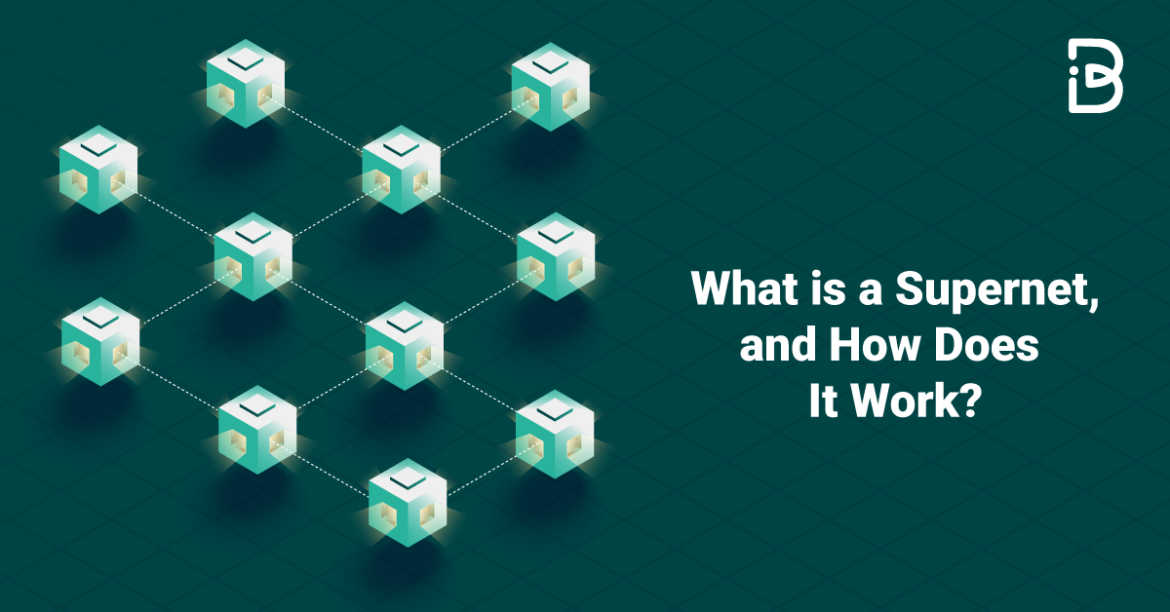Introduction
Table of Contents
Supernets allow for connection between various blockchain networks, significantly increasing the overall system’s usefulness by allowing for the transfer of assets and data between them.
Interconnected networks can also enable pooled infrastructure and resources, reducing costs and increasing overall effectiveness. Assets’ liquidity can be significantly improved by being accessible across different networks, which will increase the value of the assets.
The idea of a supernet, how to create it, its benefits and drawbacks, and how it differs from a subnet will all be covered in this article.
What is a Supernet?
A supernet often referred to as a metanet, is a network of networks that enables communication and interoperability between various blockchain networks.
A supernet is a decentralized network that enables communication and interaction between several blockchain platforms without the need for a single middleman, resulting in a cohesive ecosystem.
Also, this can greatly improve the efficiency and speed of communications and transactions among different blockchains.
A supernet also has the advantage of facilitating the development of new decentralized services and apps that can combine the strengths of many blockchains.
This may create fresh opportunities for development and innovation in the blockchain industry. Cross-chain communication is another feature of supernet that enables chains to connect and transact with one another, increasing the value for users.
How Does a Supernet Work?
A supernet is implemented using a variety of protocols and technologies, including sidechains, cross-chain communication protocols, and atomic swaps. These tools serve as a sort of “bridge” between various networks by enabling communication and interaction between various blockchains.
Atomic swaps, also known as atomic cross-chain trade, make it possible to transfer cryptocurrencies without the aid of a centralized middleman. To do this, a smart contract that encrypts the assets being traded unlocks them after the trade is finished, and releases the assets on the other blockchain is created on one blockchain.
This eliminates the need for a centralized exchange and permits the movement of assets between blockchains.
Cross-chain communication protocols like Cosmos and Polkadot are used to provide communication and interaction between multiple blockchains. These protocols allow for the transfer of data and assets between many blockchains as well as the creation of decentralized applications that can combine the benefits of various blockchains.
Sidechains are another another technology used in a supernet. An extra blockchain, known as a sidechain, is linked to a main blockchain and allows for the transfer of assets between the two.
Increased scalability, anonymity, and the ability to test out novel technologies and consensus algorithms without compromising the primary blockchain are all made possible by this.
How to Supernet a Network?
A supernet, or network of networks, can be built using a variety of technologies and protocols, and it is a complicated process. Here is a general overview of the steps involved in creating a supernet:
Identify the Networks to be Connected
The first step in creating a supernet is to determine which blockchain networks will be connected. These networks’ protocols and goals should be the same to enable easy communication and interaction.
Implement Atomic Swaps
A crucial piece of technology to enable the transfer of assets among various blockchains, atomic swaps allow cross-chain trade among various blockchains.
Develop Cross-Chain Communication Protocols
Cross-chain communication protocols, such as Cosmos and other corresponding protocols, must be created to enable communication and interaction across various blockchains. These protocols enable the exchange of information and assets between several blockchains.
Create Sidechains
A sidechain is a separate blockchain that runs parallel to a main blockchain and is connected to it through a two-way peg. This means that assets can be transferred from the main blockchain to the sidechain and vice versa. Each sidechain in a supernet has a specialized function, such as providing privacy and scalability or supporting particular assets.
Test and Deploy
Once the supernet infrastructure is set up, it’s vital to test it thoroughly before deploying it. This step will help identify and fix any bugs or errors that may exist.
Advantages of Supernetting
CIDR is a technique used to create a supernet address by combining multiple network addresses. It has several advantages, including:
- Efficient use of IP addresses: More effective use of IP addresses is made possible by supernetting, which joins several networks into a single supernet. This can aid in IP address conservation and prevent IP address depletion.
- Improved routing efficiency: Supernetting can help minimize the number of entries in routing tables, which can lower the amount of memory and processing power needed to route traffic, resulting in improved routing efficiency.
- Easier network management: Supernetting can make network management easier by reducing the number of networks that need to be managed and configured. This can help to simplify network administration and reduce the number of errors and misconfigurations.
- Interoperability: It is a central feature of the SuperNet network and is achieved through the use of sidechains and cross-chain atomic swaps. This allows users to manage and trade digital assets across different blockchains in a seamless and efficient manner.
- Scalability: Supernetting enables the construction of networks that may be expanded or contracted as necessary to meet changing demands.
Disadvantages of Supernetting
While supernetting, also known as CIDR, has many advantages, there are also some potential drawbacks to consider:
- Complexity: It can be a challenging technique that necessitates a solid grasp of IP addressing and network subnetting to perform supernetting. Furthermore, it may necessitate the use of specialized software and hardware, increasing the cost and network complexity.
- Security risks: If supernetting is done incorrectly, it can create new security problems. Combining several networks into a single supernet might increase the attack surface and make network security more challenging.
- Compatibility issues: Supernetting can create compatibility issues with some network devices or software that may not support CIDR.
- Increased complexity in routing: Supernetting can make it risky to find the proper path for packets, which can lead to an increase in routing complexity. Increased latency and poorer network performance may result from this.
- Lack of granularity: Supernetting can make it more difficult to segment a network and create smaller, more secure subnets. Access control to particular network resources or devices may become more difficult as a result.
- Limited scalability: Supernetting can limit scalability in the sense that it can create difficulties in adding new networks to the existing supernet.
How to Manage Supernets
A thorough understanding of IP addressing and network subnetting is necessary for managing a supernet. Here are some general requirements for managing a supernet:
Develop a Network Plan
A thorough network strategy that specifies the goals and objectives of the network, as well as the particular requirements for each unique network that will be included in the supernet, must be created prior to the implementation of the supernet.
Establish Governance
Establish clear lines of responsibility and decision-making processes for the supernet. This includes determining who will be responsible for managing the network, who will have access to it, and who will be able to make changes to the network’s configuration.
Train the Staff
The supernet management team must possess the knowledge and abilities required to set up and run the network. They ought to receive instruction on how to use the particular technologies and protocols employed by the supernet.
Plan and Implement Network Integration
Establish how the various networks will be connected to one another and how they will exchange resources as part of the bigger network integration.
Then, install the required hardware and software to link the networks together and incorporate them into the supernet. This could comprise network management software, switches, routers and firewalls.
Conclusion
The Supernet protocol is an innovative concept that has the potential to revolutionize how blockchains communicate with each other. It enables cross-chain transactions, creating a unified and interconnected ecosystem of blockchains.
The Supernet protocol achieves this through the use of Atomic Swaps and Komodo Smart Chains, providing interoperability, decentralization, scalability, and security.
As the blockchain industry continues to grow, the Supernet protocol will become increasingly important in enabling the seamless transfer of assets between different blockchains.

